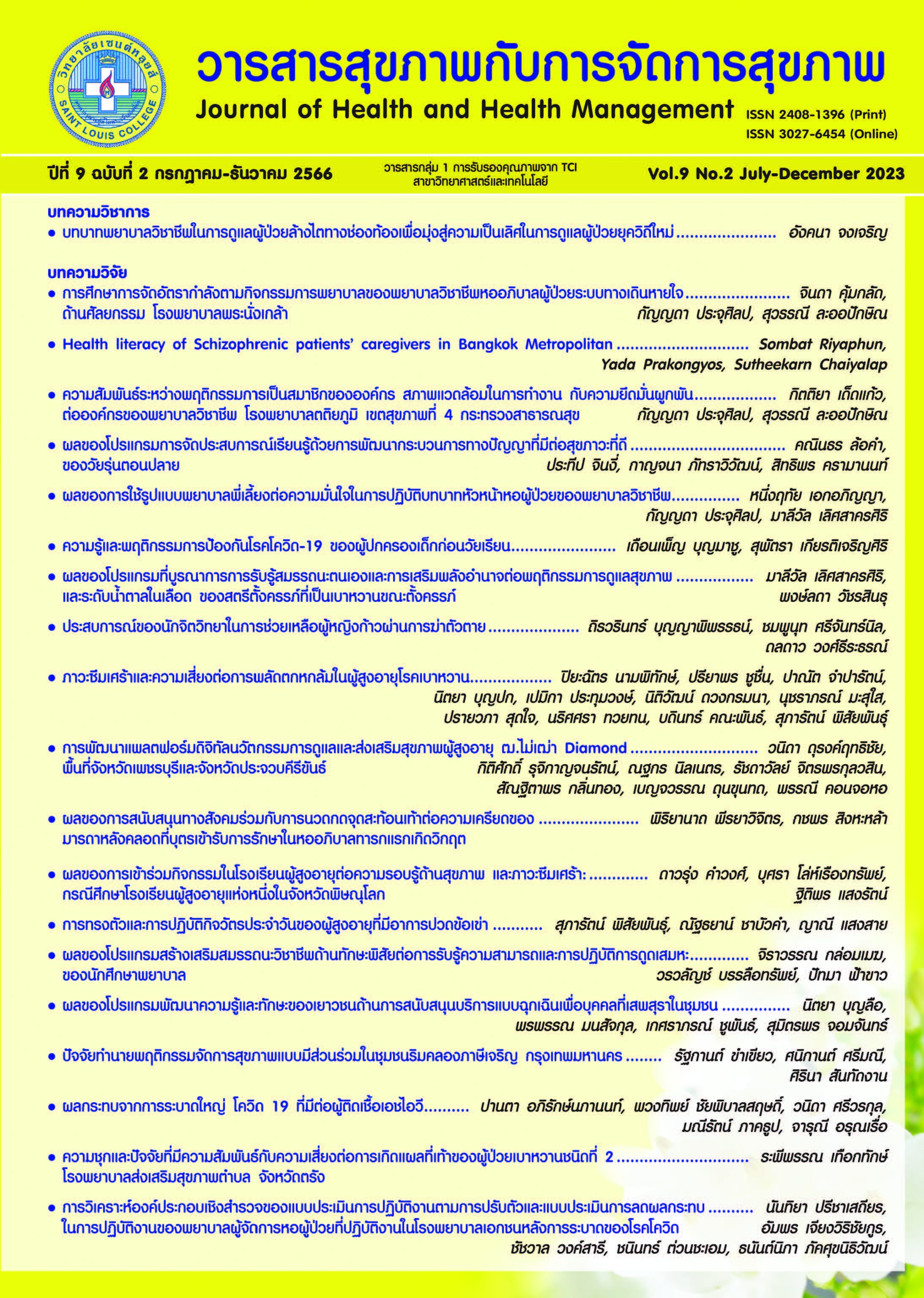Factors Predicting the Participatory Health Management in Klong Phasi Charoen Waterfront Community
Keywords:
Participatory Health Managements, CommunityAbstract
This descriptive research aimed to study the participatory health management of people living in Klong Phasi Charoen Waterfront community and examine the relationship between predisposing, enabling and reinforcing factors and participatory health management. Sample size was 138, calculated using G*Power version 3.1.9.7. Research instrument was a questionnaire including 5 parts: demographic data, predisposing factors, enabling factors, reinforcing factors, and participatory health management behaviors, which all were validated and approved by professional experts and The Cronbach’s alpha coefficient reliability of the questionnaire was tested yielding values of .91 and .954 respectively. Data were analyzed using frequency, percentage, Pearson product moment correlation, and multiple regression analysis. The research findings were as follows. 1) The majority of people living in Phasi Charoen waterfront community had participatory health managements at a moderate level ( = 3.06, SD = .571). 2) The predisposing factors, enabling factors, and reinforcing factors correlated with participatory health managements, were significantly positive (r = .409, p< .01, r = .577, p< .01, and r = .545, p< .01, respectively). 3) The enabling factors, and reinforcing factors together with these two variables, accounted for 36.4% of the variance in participatory health managements of living by the Phasi Charoen Canal (significance at the 1% level).
References
กองโรคไม่ติดต่อ กรมควบคุมโรค. (2565). รายงานสถานการณ์โรค NCDs พ.ศ. 2562. กรุงเทพ: อักษรกราฟฟิคแอนด์ดีไซน์
ชิดชนก ปลื้มปรีดี และพรเพ็ญ อรัณยะนาค. (2563). สุขภาวะชุมชนและการมีส่วนร่วมของประชาชนในการมาใช้บริการศูนย์ชุมชนสร้างสรรค์ภาษีเจริญ(รายงานวิจัย). กรุงเทพ: กรมอนามัยกระทรวงสาธารณสุข
นิลภา จิระรัตนวรรณะ, สุคนธ์ วรรธนะอมร และศรีสุดา รัศมีพงศ์. (2562). การมีส่วนร่วมของชุมชนในการสร้างเสริมสุขภาพ. วารสารมหาจุฬาวิชาการ, 6(พิเศษ), 365 – 381.
บุรฉัตร จันทร์แดง, เสาวลักษณ์ โกศลกิตติอัมพร และสัญญา เคณาภูมิ. (2561). กรอบแนวคิดการวิจัยเชิงพฤติกรรมศาสตร์. วารสารสหวิทยาการวิจัย, 8(1), 49-60.
พวงเพชร์ เพ็ชรเกตุ และไกรสร อัมมวรรธน์. (2561). ความสัมพันธ์ระหว่างรับรู้ภาวะสุขภาพและพฤติกรรมการดูแลสุขภาพของผู้หญิงวัยทองในเขตอำเภอศรีราชา จังหวัดชลบุรี. วารสารบัณฑิตศึกษา มหาวิทยาลัยธุรกิจบัณฑิตย์, 6(1), 1464-1472.
ศิลป์ชัย เนตรทานนท์ และ อุทัยวรรณ โคกตาทอง. (2558). รูปแบบการส่งเสริมสุขภาพวัยทำงานในชุมชน เขตสุขภาพที่ 5 (รายงานการวิจัย). สืบค้นจาก https://hpc.go.th/rcenter/_fulltext/ 20210830102343_4714 /20210830110522_718.pdf.
ศศิวิมล บูรณะเรข, พิมพ์รัตน์ ธรรมรักษา, ไขนภา แก้วจันทรา, และมญช์พาณี ขำวงษ์. (2560). ภาวะสุขภาพและการเข้าถึงบริการสุขภาพ. วารสารวิทยาลัยพยาบาลบรมราชชนนี กรุงเทพ, 2(33), 54-63.
สำนักงานกองทุนสนับสนุนการสร้างเสริมสุขภาพ. (2564). โครงการศึกษาพัฒนาอุปกรณ์และพื้นที่ต้นแบบเพื่อส่งเสริมกิจกรรมทางกายและสนับสนุนให้เกิดเครือข่ายชุมชนสุขภาวะ. สืบค้นจาก https://dol.thaihealth.or.th/Media/Index/a8b12b25-a193-eb11-80ec-00155d09b41f
สำนักงานคณะกรรมการสุขภาพแห่งชาติ. (2565). ธรรมนูญว่าด้วยระบบสุขภาพแห่งชาติ ฉบับที่ 3 พ.ศ. 2556 (ฉบับผ่านคณะรัฐมนตรี). สืบค้นจาก https://www.nationalhealth.or.th/sites/ default/files/upload_files/ThamanoonV3_23Jun2022.pdf
สุธาวัลย์ ธรรมสังวาลย์. (2565). การออกแบบกราฟิกชุด “สองฝั่งคลองภาษีเจริญ” เพื่อสื่อสารเอกลักษณ์ชุมชน ผ่านการวาดภาพฝาผนัง ณ ซอยเพชรเกษม 27 เขตภาษีเจริญ กรุงเทพมหานคร. วารสารนิเทศสยามปริทัศน์, 21(2), 28-46.
แสงเดือน กิ่งแก้ว และนุสรา ประเสริฐศรี. (2559). ความสัมพันธ์ระหว่างความฉลาดทางสุขภาพและพฤติกรรมสุขภาพของผู้สูงอายุที่เป็นโรคเรื้อรังหลายโรค. วารสารพยาบาลกระทรวงสาธารณสุข, 25(3), 43-54.
อรุณรัตน์ สารวิโรจน์ และกานดา จันทร์แย้ม. (2557). ปัจจัยที่มีอิทธิพลต่อพฤติกรรมส่งเสริมสุขภาพของนักศึกษามหาวิทยาลัยสงขานครินทร์ วิทยาเขตหาดใหญ่. วารสารเกษตรศาสตร์ (สังคม), 35(2), 223-234.
Bishoge, O. K., Aremu, A. K., Ajayi, D. D., & Mfinanga, S. G. (2023). Factors that influence individual and community behavioural change regarding environmental health. Journal of Health Research, 37(1), 33-43.
Green, L. W., & Kreuter, M. W. (2005). Health Promotion Planning: An educational and ecological approach (4thEdition). New York: McGraw Hill.
Hamidi, S., Ewing, R., Tatalovich, Z., Grace, J. B., & Berrigan, D. (2018). Associations between urban sprawl and life expectancy in the United States. International journal of environmental research and public health, 15(5), 861-872.
Jana, A., & Chattopadhyay, A. (2022). Prevalence and potential determinants of chronic disease among elderly in India: rural-urban perspectives. Plos one, 17(3), e0264937.
McMichael, A. J. (2000). The urban environment and health in a world of increasing globalization: issues for developing countries. Bulletin of the world Health Organization, 78(9), 1117-1126.
Pender, N. J., Murdaugh, C. L., & Parsons, M. A. (2002). Health promotion in nursing practice (4th ed.) New Jersey: Pearson Education.
Porter, C. M. (2016). Revisiting Precede–Proceed: A leading model for ecological and ethical health promotion. Health Education Journal, 75(6), 753-764.
World Health Organization. (2012). Ottawa charter for health promotion. Retrieved from https://www.who.int/publications/i/item/WH-1987.
Downloads
Published
How to Cite
Issue
Section
License
Copyright (c) 2023 Journal of health and health management

This work is licensed under a Creative Commons Attribution-NonCommercial-NoDerivatives 4.0 International License.




